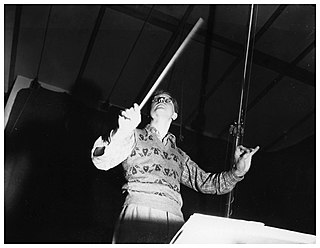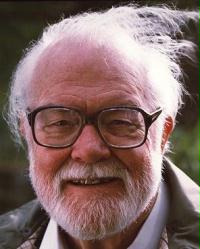Related Research Articles

Ralph Vaughan Williams, was an English composer. His works include operas, ballets, chamber music, secular and religious vocal pieces and orchestral compositions including nine symphonies, written over sixty years. Strongly influenced by Tudor music and English folk-song, his output marked a decisive break in British music from its German-dominated style of the 19th century.

Douglas Gordon Lilburn was a New Zealand composer.
Symphony No. 5 in D major by the English composer Ralph Vaughan Williams was written between 1938 and 1943. In style it represents a shift away from the violent dissonance of his Fourth Symphony, and a return to the gentler style of the earlier Pastoral Symphony.

Sir Charles Barnard Groves CBE was an English conductor. He was known for the breadth of his repertoire and for encouraging contemporary composers and young conductors.
Serenade to Music is an orchestral concert work completed in 1938 by English composer Ralph Vaughan Williams, written as a tribute to conductor Sir Henry Wood. It features an orchestra and 16 vocal soloists, with lyrics adapted from the discussion about music and the music of the spheres from Act V, Scene I from the play The Merchant of Venice by William Shakespeare. Williams later arranged the piece into versions for chorus and orchestra and solo violin and orchestra.

Robin Humphrey Milford was an English composer and music teacher.

Sir George Dyson was an English musician and composer. After studying at the Royal College of Music (RCM) in London, and army service in the First World War, he was a schoolmaster and college lecturer. In 1938 he became director of the RCM, the first of its alumni to do so. As director he instituted financial and organisational reforms and steered the college through the difficult days of the Second World War.

Edgar Leslie Bainton was a British-born, latterly Australian-resident composer. He is remembered today mainly for his liturgical anthem And I saw a new heaven, a popular work in the repertoire of Anglican church music, but during recent years Bainton's other musical works, neglected for decades, have been increasingly often heard on CD.
The Wasps is incidental music composed by the British composer Ralph Vaughan Williams in 1909. It was written for the Cambridge Greek Play production of Aristophanes' The Wasps at Trinity College, Cambridge, and was Vaughan Williams' first of only three forays into incidental music. A later performance of the work was one of only a small number of performances conducted by Vaughan Williams that was committed to a recording.
Aotearoa is a concert overture written for orchestra by New Zealand composer Douglas Lilburn in 1940. The overture is the first of three early works by Lilburn which centre on the theme of national identity; the other two are Landfall in Unknown Seas (1942), for narrator and orchestra, and the tone poem A Song of Islands (1946).
Landfall in Unknown Seas is a work for narrator and string orchestra written by New Zealand composer Douglas Lilburn and poet Allen Curnow in 1942. It was the second in Lilburn's early trilogy of works dealing with the theme of New Zealand identity, following the overture Aotearoa and preceding A Song of Islands.
A Song of Islands is a tone poem written for orchestra by New Zealand composer Douglas Lilburn in 1946. The work is the last in a trilogy of pieces exploring the theme of New Zealand identity; it was preceded by the overture Aotearoa (1940) and Landfall in Unknown Seas (1942) for narrator and string orchestra.
Sir William David Southgate is a New Zealand conductor and composer. He was the first New Zealand-based artist to be knighted.
The Symphony No. 1 of Douglas Lilburn was completed in 1949, and had its premiere in 1951. The symphony is in three integrated movements; a typical performance lasts around 30 minutes.
The Symphony No. 3 of Douglas Lilburn was completed in 1961, in response to a sabbatical from Victoria University of Wellington. It was given its premiere the following year, and published by Faber Music around 1968.
David Andross Farquhar was a New Zealand composer and professor of music at Victoria University of Wellington.
This is a summary of 1926 in music in the United Kingdom.
George Dyson's Psalm CVII Symphony and Overture, is a choral symphony written in 1910 as part of the composer's studies at Oxford for his Doctorate in Music. Not rediscovered until 2014, it is one of the few compositions surviving from the composer's early years.

The Carnegie Collection of British Music was founded in 1917 by the Carnegie Trust to encourage the publication of large scale British musical works. Composers were asked to submit their manuscripts to an anonymous panel. On the panel at various times were Hugh Allen, Granville Bantock, Arnold Bax, Dan Godfrey, Henry Hadow and Donald Tovey. Up to six works per year were chosen for an award – publication at the expense of the Trust, in conjunction with music publishers Stainer & Bell. Unfortunately the war delayed things for the earliest prizewinners. The first to be published was the Piano Quartet in A minor by Herbert Howells.. By the end of 1920 some 13 works were available. 30 were out by the end of 1922, and when the scheme finally closed in 1928 some 60 substantial works that might not otherwise have seen the light of day had been issued under the Carnegie Collection of British Music imprint.
References
- 1 2 Lilburn, Douglas. "Drysdale Overture". SOUNZ. Retrieved 1 July 2013.
- 1 2 3 Lilburn, Douglas (2014). Robert Hoskins (ed.). Drysdale Overture. Wellington: Promethean Editions. ISBN 978-1-877564-48-2.